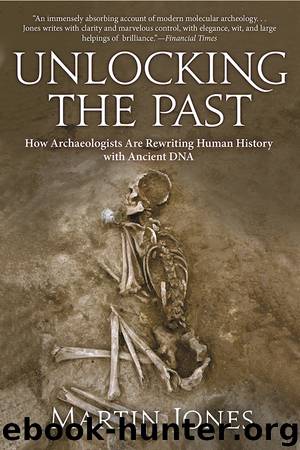Unlocking the Past by Martin Jones

Author:Martin Jones
Language: eng
Format: epub
Publisher: Arcade Publishing
Published: 2016-02-25T16:00:00+00:00
waves of migration or depletion?
The wave-front model of migration and its relation to ‘arcs in the sand’ would work better if particular genetic types were found to be absent beyond the arc. That would indicate that a particular lineage only got so far. What we find instead is that lineages may be rarer or absent in the lee of the arc. The C lineage is less frequent in the north, and two lineages seem to be completely absent along the presumed pathway from Asia into America. One of these is lineage B; the other, known as lineage X, is one of the rarer lineages that had begun to turn up. In both cases, some had speculated on quite separate journeys to account for their complete absence from the northern land route. Could lineages B and X have nothing to do with the northern bridge and instead have reached America by sea?
The first ancient DNA data from pre-Columbian America could in fact have supported the idea of arrival in part by sea. These early pre-Columbian amplifications yielded only A, C and D lineages. When Erika Hagelberg’s study of South American mummies finally came up with the nine base-pair deletion characteristic of lineage B, a short-lived but romantic notion of ancient Pacific island journeyers began to recede from the account of American settlement. Since then, a significant proportion of the 500 or so pre-Columbian individuals examined have proven to be of lineage B, including an 8,000-year-old hunter stranded 3,000 metres up in the Rockies. The B lineage was clearly an early overland arrival, much as Forster and others argued, which had disappeared from the path of its entry. This left the yet more enigmatic lineage X.
Merriwether had not been alone in finding lineages that fell outside the classic four lineages of Wallace. One recurrent outsider became labelled ‘X’. It was characterized by mutations along the control region at positions 16,223 and 16,278. In one native American community, the Ojibwa, as many as one in four were of this rarer lineage. Like lineage B, it was absent from its presumed ancestral path from Siberia across to Alaska and Canada. What is more, this lineage seemed to be absent throughout Asia. The first geneticist to recognize this lineage, Antonio Torroni, had found the lineage, not in Asia, but in various parts of Europe. Could it be that some forgotten European travellers had carried the lineage across the Atlantic Ocean? Not according to Forster’s calculations using the molecular clock. These placed lineage X way back in prehistory, well before such a journey was feasible. Once again, the ancient DNA might cast light on this issue. Most ancient DNA studies of pre-Columbian Indians had targeted too small a sample to pick up rare lineages. There were however some important exceptions.
Download
This site does not store any files on its server. We only index and link to content provided by other sites. Please contact the content providers to delete copyright contents if any and email us, we'll remove relevant links or contents immediately.
| Fossils | Game Theory |
| Genetics | Molecular Biology |
| Organic | Paleontology |
Sapiens: A Brief History of Humankind by Yuval Noah Harari(13036)
Sapiens by Yuval Noah Harari(4528)
Homo Deus: A Brief History of Tomorrow by Yuval Noah Harari(4272)
Pale Blue Dot by Carl Sagan(3995)
Origin Story: A Big History of Everything by David Christian(3133)
Livewired by David Eagleman(3113)
Brief Answers to the Big Questions by Stephen Hawking(2872)
Inferior by Angela Saini(2829)
Origin Story by David Christian(2677)
The Evolution of Beauty by Richard O. Prum(2550)
Signature in the Cell: DNA and the Evidence for Intelligent Design by Stephen C. Meyer(2495)
The Gene: An Intimate History by Siddhartha Mukherjee(2487)
Aliens by Jim Al-Khalili(2376)
How The Mind Works by Steven Pinker(2206)
Sex at Dawn: The Prehistoric Origins of Modern Sexuality by Ryan Christopher(2148)
From Bacteria to Bach and Back by Daniel C. Dennett(2144)
A Short History of Nearly Everything by Bryson Bill(2131)
Endless Forms Most Beautiful by Sean B. Carroll(2079)
Who We Are and How We Got Here by David Reich(2056)
